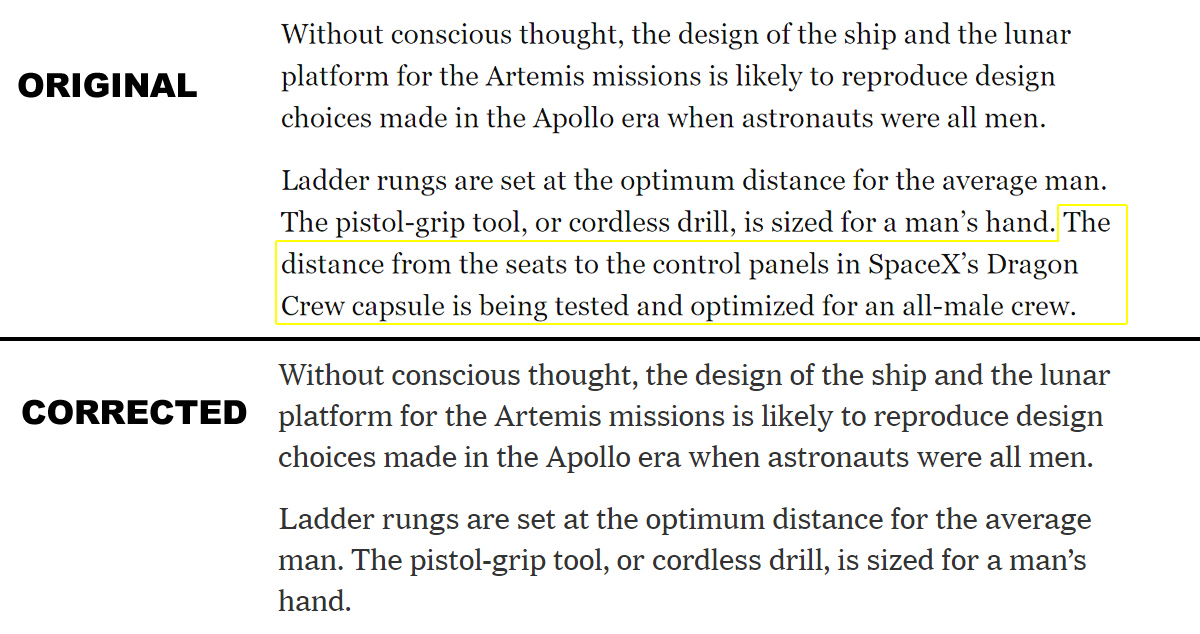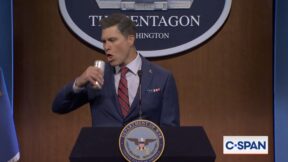NYT Forced to Make Absurd Correction Undermining ‘Essay about Gender Bias’ in Space Exploration

The New York Times last week honored the anniversary of the moon landing by attacking American space exploration for being gender biased. On Tuesday of this week, however, two pretty major corrections were made to the piece.
On the corrections page — five days after the bias essay ran — amid corrections like how to spell the name “Walker”, the paper of record offered this: “An essay about gender bias in American space exploration misstated the genders of people involved in testing of the SpaceX’s Crew Dragon capsule. The testing included both men and women, not only men.”
The essay about gender bias said a program was all male that wasn’t.
“If we do not acknowledge the gender bias of the early space program, it becomes difficult to move past it,” last week’s essay began, before explaining that there were adjustments to be made to physical parameters in designs when, over 40 years ago, NASA began to integrate female astronauts into space programs.
Some spacesuits from that time period still remain, and remain too large.
What are the lessons to be learned from NASA’s failure to fly women during the Apollo era? The most recent lesson emerged in April, when NASA had scheduled a spacewalk that was, quite by accident, staffed by two female astronauts. The agency had to restaff the spacewalk because it had only one spacesuit that was the correct size for both women.
(In that section, they also apparently incorrectly asserted, but later corrected, that a planned spacewalk took place, though it did not.)
“This is not an indictment of NASA in 2019. But it does demonstrate a causal chain that begins with the Apollo program and leads through to present-day staffing choices,” wrote fiction author and puppeteer Mary Robinette Kowal.
She explains that cooling in the spacesuits is also designed around where men sweat most, much like offices are cool enough for men but leave women wearing sweaters.
“Women are asked to compromise about seemingly small things in order to participate,” wrote Kowal. “Every time we do that, we carry those imprints forward into the future.”
“It is worth looking back to the 1950s,” she continued, referring to when, 60 years, 3 months, 8 days prior to her essay, NASA nearly had a space program focused on women because of their superior physical attributes. She then covered examples of gender bias from that bygone era as well as achievements of women in flight, before circling back to spacesuit design.
If you read the article today, there is no mention of SpaceX. It was removed. Here is a before/after.

On Twitter, some refer to this as a “significant” or “embarrassing” correction.
Well, THIS seems… significant, @nytimes:
“An essay about gender bias in American space exploration misstated the genders of people involved in testing of the SpaceX’s Crew Dragon capsule. The testing included both men and women, not only men.”https://t.co/kCoQD2yuvt pic.twitter.com/F6z0IREAev
— Jeryl Bier (@JerylBier) July 23, 2019
It’s not partisan bias to see it that way. This change, which the New York Times obviously sees as minor, alters the character of the essay significantly.
The essay says “This is not an indictment of NASA in 2019,” but of course, it is exactly that, and meant as that. The author refers to a “causal chain” between misogynist bias by the early, evil NASA, and then purports to show how that bias still hurts women in space today. She writes that NASA is “likely to reproduce” gender biased design, and offered the SpaceX example as evidence. A program from today, still biased against women, and oh by the way, it’s ALL-MALE.
That was the knife, the subtly-delivered, devastating proof. It’s an aspect of most good essays.
‘Oh and by the way? We’re still doing gender bias in space science today. Here’s an all-male program currently underway’ is her intended coup de grace.
Only it wasn’t all male. In an article about gender bias, what bias was it that made the author think the program was all-male?
The editorial concludes “if we want to land the first woman on the moon, let’s make sure she has tools designed with her in mind. Eliminating the legacy of gender bias is just one small step.”
In other words, if NASA is to put a woman on the moon, that woman should … have a spacesuit that fits. One would think that goes without saying. While NASA is at it, perhaps they can add in some new computers and video cameras and other items that likewise weren’t designed and produced 50 years ago. If I’m not mistaken, some of our technology has changed in the last half-century, too.
By the way? That wasn’t the only space correction issued by the paper this morning.
? – “It showed a view of Earth, not the moon.”
“A picture caption with an article on Saturday… misidentified the object in the image taken from the Apollo 11 spacecraft. It showed a view of Earth, not the moon.”https://t.co/kCoQD2yuvt pic.twitter.com/Mtqo5j187u
— Jeryl Bier (@JerylBier) July 23, 2019
After 50 years, you’d think think America’s premier newspaper could tell the difference between a photo of the earth from the moon and vice versa.
The Times had to correct a gender bias essay that misstated gender bias. They also had a headline last week saying the Soviets were the real space race winners. Maybe it’s not the agenda of NASA and SpaceX we should be worrying about.
Then again, also on the corrections page, they highlighted an error in describing a “Veronica Mars” plot. Maybe space words just aren’t their thing, altogether.
This is an opinion piece. The views expressed in this article are those of just the author.




